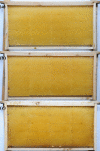Cell orientation characteristics of the natural combs of honey bee colonies
- PMID: 35130275
- PMCID: PMC8820595
- DOI: 10.1371/journal.pone.0263249
Cell orientation characteristics of the natural combs of honey bee colonies
Abstract
The cell orientation characteristics of the natural combs of honey bees have received much research attention. Although natural combs have been shown to be composed of cells with three orientations-vertical, intermediate (oblique), and horizontal-the proportion of comb cells in these three orientations varies. Knowledge of the comb-building preferences of honey bees is essential for the installation of wax comb foundations, and clarification of the cell orientation characteristics of natural honey bee combs is important for beekeeping. The purpose of this study was to determine the cell orientation characteristics of natural combs of Eastern honey bees (Apis cerana cerana) and Western honey bees (Apis mellifera ligustica). Newly built combs were used to measure the orientation of hexagonal cells and calculate the proportion of cells in different orientations relative to the total number of cells. The number of eggs laid by queens in the cells of different orientations was also determined. The orientation of cells in the natural combs of Eastern and Western honey bees was determined based on the value of the minimum included angle between the pair of parallel cell walls and a vertical line connecting the top and bottom bars of the movable frame in the geometric plane of the comb: 0°≤θ≤10°, 10°<θ≤20°, and 20°<θ≤30° for vertical, intermediate, and horizontal orientations, respectively. Natural combs were composed of cells with at least one orientation (vertical or horizontal), two orientations (vertical + intermediate (oblique) or vertical + horizontal), or three orientations (vertical + intermediate + horizontal), and the proportions of combs with the three aforementioned configurations differed. Both Eastern honey bees and Western honey bees preferred building combs with cells in a vertical orientation. Queens showed no clear preference for laying eggs in cells of specific orientations. The results of this study provide new insight that could aid the production and cutting of wax comb foundations of Eastern and Western honey bees. Our study highlights the importance of installing wax comb foundations compatible with the comb-building preferences of bees.
Conflict of interest statement
We declare no conflict of interest and no competing or financial interests.
Figures














Similar articles
-
An experiment on comb orientation by honey bees (Hymenoptera: Apidae) in traditional hives.J Econ Entomol. 2012 Jun;105(3):777-82. doi: 10.1603/ec11410. J Econ Entomol. 2012. PMID: 22812112
-
Use of Relay Method for Enhancing Comb Construction by Apis cerana cerana Utilizing Apis mellifera ligustica.Insects. 2025 Jan 8;16(1):52. doi: 10.3390/insects16010052. Insects. 2025. PMID: 39859633 Free PMC article.
-
Evaluating and Comparing the Natural Cell Structure and Dimensions of Honey Bee Comb Cells of Chinese Bee, Apis cerana cerana (Hymenoptera: Apidae) and Italian Bee, Apis mellifera ligustica (Hymenoptera: Apidae).J Insect Sci. 2021 Jul 1;21(4):1. doi: 10.1093/jisesa/ieab042. J Insect Sci. 2021. PMID: 34214154 Free PMC article.
-
Varroa destructor: how does it harm Apis mellifera honey bees and what can be done about it?Emerg Top Life Sci. 2020 Jul 2;4(1):45-57. doi: 10.1042/ETLS20190125. Emerg Top Life Sci. 2020. PMID: 32537655 Free PMC article. Review.
-
Beekeeping from Antiquity Through the Middle Ages.Annu Rev Entomol. 2017 Jan 31;62:249-264. doi: 10.1146/annurev-ento-031616-035115. Annu Rev Entomol. 2017. PMID: 28141962 Review.
Cited by
-
Honeybees adapt to a range of comb cell sizes by merging, tilting, and layering their construction.PLoS Biol. 2025 Aug 26;23(8):e3003253. doi: 10.1371/journal.pbio.3003253. eCollection 2025 Aug. PLoS Biol. 2025. PMID: 40857245 Free PMC article.
References
-
- Gillette CP. Apiary Experiments FoundationIn Comb Building. Fort Collins, Colorado.: The experiment station; 1900.
-
- Dervishian MG. The Wax Comb Foundation that Never Sags. Bee World. 1919;1(10–12):197–8. doi: 10.1080/0005772x.1919.11093822 - DOI
-
- Digges JG. The Practical Bee Guide: A Manual of Modern Beekeeping. London, Simpkin, Marshall; 1921. 283 p. doi: 10.5962/bhl.title.53890 - DOI
-
- Allen RMY. Arm Chair Thoughts. Bee World. 1928;9(12):196–7. doi: 10.1080/0005772X.1928.11096288 - DOI
-
- Betts AD. Should Foundation be put in Skew? Bee World. 1929;10(6):87-. doi: 10.1080/0005772X.1929.11092821 - DOI
Publication types
MeSH terms
LinkOut - more resources
Full Text Sources

